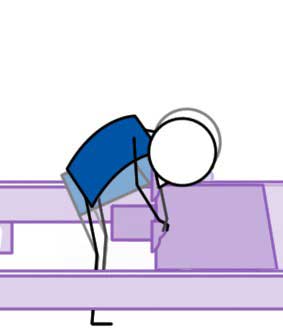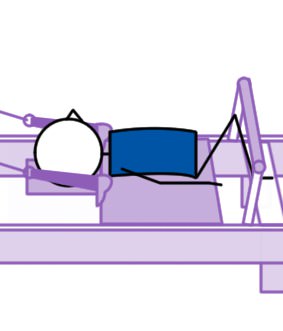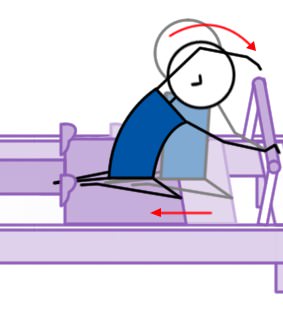
| Category: | Pilates Lesson Planner |
|---|---|
| Sub Category: | Reformer |
| Types: | Forward Bend, Standing, Stretch |
| Anatomy: | Core, Hamstrings, Psoas |
| Therapy: | Poor Posture |
| Drishti: | Tips Of Feet |
| Dosha: | Kapha, Pitta |
Use a medium tension spring. Stand in well of reformer facing headrests. Fold over with a long spine. Hold onto one headrest with both hands. On exhale, draw carriage in and round back, curling tailbone under and drawing head down. Inhale to start position. Repeat on other side.
Strengthens core. Promotes spinal flexibility. Improves posture. Enhances coordination. Engages deep abdominal and back muscles.
Beginner: Knees slightly bent for reduced strain.Intermediate: Alternate single-arm holds to increase core engagement. Advanced: Hold the rounded-back position briefly before returning.
Avoid locking knees or straining wrists.
Click here for lots of FREE downloadable Yoga lesson plans.
Click here for lots of FREE downloadable Pilates lesson plans.
- opt
- Reformer
- Reformer
- STOTT REFORMER REPERTOIRE: Essential & Intermediate
- Reformer
- opt
- Pilates for Children
- Club Pilates - Reformer Postures
- Final reformer
- 1.5 Reformer Flow
- reformer
- reformer icons
- reformer icons
- All Reformer Excersises
- All Reformer Exercises
- Pilates 1 abs
- Reformer Exercises
- Flow 1.5 ideas - delete
30 Modifications for the Reverse Elephant on Reformer: A Comprehensive Guide
The Reverse Elephant On Reformer is a dynamic exercise that targets the core, stretches the hamstrings, and promotes spinal mobility. It is an essential part of the Intermediate category in the Reformer Pilates Expansion Card Deck, an expansion of the Reformer Pilates Deck.
In this post, we will explore 30 different modifications for the Reverse Elephant, ranging from beginner to advanced levels, so you can adjust the intensity and technique to suit your personal needs and progress.
Steps for the Reverse Elephant on Reformer
Before delving into the modifications, it’s important to understand the basic technique for the Reverse Elephant On Reformer:
Start: Use a medium-tension spring on the reformer.
Stand: Stand in the well of the reformer, facing the headrests.
Fold: Fold forward with a long spine, hands placed on the headrest for support.
Exhale: Draw the carriage in, rounding your back, curling your tailbone under, and lowering your head.
Inhale: Return to the starting position with a long spine.
Repeat: Repeat the movement on the opposite side, maintaining control and stability throughout.
This exercise strengthens the abdominal muscles, stretches the hamstrings, and promotes spinal articulation and control. While the basic movement is already challenging, it can be modified to accommodate various levels of experience and ability.
10 Beginner Modifications For Reverse Elephant on Reformer
Beginner Modification 1: Keep Knees Slightly Bent
For those new to Pilates or the Reverse Elephant, start with a slight bend in the knees to reduce the strain on the hamstrings and lower back. This adjustment allows you to focus on the core and upper body without overextending the legs.
Beginner Modification 2: Hands on the Reformer Bar
If reaching the headrest feels uncomfortable or challenging, place your hands on the reformer bar instead. This provides additional support and allows you to focus on the movement without worrying about balance or stability.
Beginner Modification 3: Slow Down the Pace
Take your time with each movement, focusing on the alignment and control of your body. Slowing down the movement helps you connect with the muscles more effectively, ensuring that your form remains precise and correct.
Beginner Modification 4: Reduce Range of Motion
Rather than fully rounding your back, only draw the carriage in slightly. This adjustment prevents you from overloading your muscles too soon while still allowing you to get a feel for the movement.
Beginner Modification 5: Use a Lighter Spring Tension
Switch to a lighter spring tension to reduce the resistance. This makes it easier to focus on form and movement, allowing you to build strength progressively without the added challenge of a heavier spring.
Beginner Modification 6: Foot Placement on the Carriage
Instead of standing with both feet on the carriage, stagger your feet. This offers more stability and makes it easier to balance throughout the exercise, ensuring you can complete each movement safely and effectively.
Beginner Modification 7: Keep Spine Neutral
Instead of rounding your spine, keep it in a neutral position, focusing on the hamstring stretch. This variation is gentler and allows beginners to work on flexibility without straining the lower back.
Beginner Modification 8: Perform the Exercise Sitting
If standing feels too intense, try performing the exercise sitting on the carriage, ensuring the spine remains long as you draw the carriage in. This allows you to still engage the core while reducing the load on the legs.
Beginner Modification 9: Shorter Reps
Begin with fewer repetitions to build stamina. By reducing the volume, you allow yourself to master the movement with less fatigue, which is ideal for new practitioners.
Beginner Modification 10: Take Breaks Between Reps
Allow yourself extra time between each repetition to recover. This ensures that you can maintain good form throughout the exercise without becoming fatigued too quickly.
10 Intermediate Modifications For Reverse Elephant on Reformer
Intermediate Modification 1: Deepen the Carriage Draw
As you become more comfortable with the exercise, begin to draw the carriage in deeper with each exhale. This increases the intensity of the core engagement and deepens the hamstring stretch.
Intermediate Modification 2: Lift One Foot Off the Carriage
Add a challenge by lifting one foot off the carriage while performing the exercise. This will force your core to work harder to maintain balance and stability.
Intermediate Modification 3: Add Arm Movement
Extend one arm forward as you draw the carriage in, then alternate lifting the opposite arm on the return. This engages the shoulders and helps improve coordination.
Intermediate Modification 4: Increase Spring Tension
Use a stronger spring tension to add resistance, which will increase the challenge for your core, glutes, and hamstrings. Be sure to maintain control as the added resistance can make the movement more difficult.
Intermediate Modification 5: Incorporate Controlled Breathing
Focus on your breathing as you exhale to draw the carriage in and inhale to return. This ensures that the movement remains fluid and helps to develop rhythm and control.
Intermediate Modification 6: Full Leg Extension
Instead of keeping your knees slightly bent, work towards extending the legs fully while maintaining a strong core to prevent over-arching the back. This modification intensifies the stretch and engages the hamstrings more deeply.
Intermediate Modification 7: Perform in a Continuous Flow
Increase the tempo of your movement slightly to create a more continuous, flowing sequence. This helps to develop stamina and coordination, while still maintaining control.
Intermediate Modification 8: Perform the Exercise on One Leg
Work on strengthening your stabilising muscles by performing the Reverse Elephant on one leg at a time. Alternate between legs to challenge your balance and engage the glutes more intensely.
Intermediate Modification 9: Increase Repetition Count
Begin increasing the number of repetitions per set. This helps build endurance and core strength, allowing you to sustain the movement longer without losing form.
Intermediate Modification 10: Focus on Pelvic Positioning
Concentrate on curling the tailbone under and lifting the pelvic floor as you draw the carriage in. This will help engage the lower abdominal muscles and create a more targeted movement.
10 Advanced Modifications For Reverse Elephant on Reformer
Advanced Modification 1: Add a Pause at the Bottom
Incorporate a pause at the bottom of the movement when your back is fully rounded and your head is lowered. Hold for a few seconds before returning to the start, intensifying the stretch and strengthening the core.
Advanced Modification 2: Perform with Both Legs Extended
Keep both legs fully extended as you perform the Reverse Elephant. This will require more hamstring flexibility and core stability, increasing the challenge significantly.
Advanced Modification 3: Use Maximum Spring Tension
Increase the spring tension to its maximum resistance to make the exercise significantly harder. This intensifies the engagement of the core and strengthens the glutes and hamstrings.
Advanced Modification 4: Combine with Leg Circles
After drawing the carriage in, hold the position and perform leg circles with one leg extended. This challenges the core and hip flexors, adding complexity to the movement.
Advanced Modification 5: Alternate Arm and Leg Lifts
Add arm and leg lifts to the movement. Lift your right arm and left leg as you draw the carriage in, and switch sides with each repetition. This increases the coordination and complexity of the exercise.
Advanced Modification 6: Hold a Plank Position
After completing the Reverse Elephant, hold a plank position with your feet on the reformer and your hands on the headrest. This will challenge your core and upper body stability.
Advanced Modification 7: Perform in a Single-Legged Split
Perform the Reverse Elephant while one leg is in a split position. This requires deep core activation and balance, forcing you to work both legs and the core simultaneously.
Advanced Modification 8: Increase Speed
Perform the exercise at a quicker pace to add an element of cardiovascular endurance. Make sure you maintain control even as the speed increases, as this will also build coordination.
Advanced Modification 9: Add Resistance Bands
Incorporate resistance bands into your Reverse Elephant. Attach them to the reformer or your feet to increase the resistance and add more intensity to the exercise.
Advanced Modification 10: Perform with No Hands on the Headrest
Perform the Reverse Elephant with your arms extended forward, not holding onto the headrest. This requires a higher level of core stability and balance as you control the movement without the additional support.
George’s Conclusion And the Reformer Pilates Card Deck
The Reverse Elephant On Reformer is a versatile and highly effective exercise for building core strength, flexibility, and coordination. Whether you are a beginner, intermediate, or advanced practitioner, the modifications outlined above allow you to tailor the movement to your own needs, helping you progress safely and effectively.
If you’re interested in further expanding your Pilates practice, the Reformer Pilates Card Deck and the Reformer Pilates Expansion Card Deck are valuable tools. These decks provide a comprehensive guide to reformer exercises, ensuring that you can continually challenge yourself and improve your technique.




 Yoga Lesson Planner
Yoga Lesson Planner
 Pilates Lesson Planner
Pilates Lesson Planner


